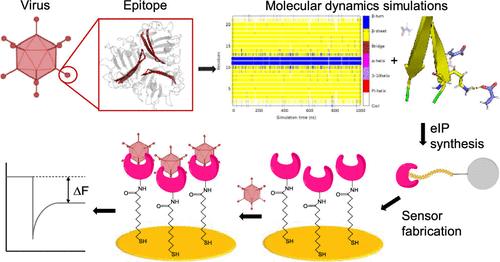Our official English website, www.x-mol.net, welcomes your feedback! (Note: you will need to create a separate account there.)
Computationally Designed Epitope-Mediated Imprinted Polymers versus Conventional Epitope Imprints for the Detection of Human Adenovirus in Water and Human Serum Samples
ACS Sensors ( IF 8.9 ) Pub Date : 2024-03-15 , DOI: 10.1021/acssensors.3c02374 Ekin Sehit 1, 2 , Guiyang Yao 1 , Giovanni Battocchio 1 , Rahil Radfar 1, 2 , Jakob Trimpert 3 , Maria A. Mroginski 1 , Roderich Süssmuth 1 , Zeynep Altintas 1, 2, 4
ACS Sensors ( IF 8.9 ) Pub Date : 2024-03-15 , DOI: 10.1021/acssensors.3c02374 Ekin Sehit 1, 2 , Guiyang Yao 1 , Giovanni Battocchio 1 , Rahil Radfar 1, 2 , Jakob Trimpert 3 , Maria A. Mroginski 1 , Roderich Süssmuth 1 , Zeynep Altintas 1, 2, 4
Affiliation

|
Detection of pathogenic viruses for point-of-care applications has attracted great attention since the COVID-19 pandemic. Current virus diagnostic tools are laborious and expensive, while requiring medically trained staff. Although user-friendly and cost-effective biosensors are utilized for virus detection, many of them rely on recognition elements that suffer major drawbacks. Herein, computationally designed epitope-imprinted polymers (eIPs) are conjugated with a portable piezoelectric sensing platform to establish a sensitive and robust biosensor for the human pathogenic adenovirus (HAdV). The template epitope is selected from the knob part of the HAdV capsid, ensuring surface accessibility. Computational simulations are performed to evaluate the conformational stability of the selected epitope. Further, molecular dynamics simulations are executed to investigate the interactions between the epitope and the different functional monomers for the smart design of eIPs. The HAdV epitope is imprinted via the solid-phase synthesis method to produce eIPs using in silico-selected ingredients. The synthetic receptors show a remarkable detection sensitivity (LOD: 102 pfu mL–1) and affinity (dissociation constant (Kd): 6.48 × 10–12 M) for HAdV. Moreover, the computational eIPs lead to around twofold improved binding behavior than the eIPs synthesized with a well-established conventional recipe. The proposed computational strategy holds enormous potential for the intelligent design of ultrasensitive imprinted polymer binders.
中文翻译:

计算设计的表位介导的印迹聚合物与传统表位印迹用于检测水和人血清样本中的人腺病毒
自 COVID-19 大流行以来,用于现场护理应用的病原病毒检测引起了高度关注。目前的病毒诊断工具既费力又昂贵,同时需要经过医学培训的工作人员。尽管用户友好且经济高效的生物传感器用于病毒检测,但其中许多依赖于存在重大缺陷的识别元件。在此,通过计算设计的表位印迹聚合物(eIP)与便携式压电传感平台结合,为人类致病性腺病毒(HAdV)建立了灵敏且强大的生物传感器。模板表位选自 HAdV 衣壳的旋钮部分,确保表面可及性。进行计算模拟以评估所选表位的构象稳定性。此外,还执行分子动力学模拟来研究表位与不同功能单体之间的相互作用,以实现 eIP 的智能设计。 HAdV 表位通过固相合成方法进行印迹,以使用计算机选定的成分生产 eIP。合成受体对 HAdV显示出卓越的检测灵敏度(LOD:10 2 pfu mL –1)和亲和力(解离常数 ( K d ):6.48 × 10 –12 M)。此外,与使用完善的传统配方合成的 eIP 相比,计算 eIP 的结合行为提高了大约两倍。所提出的计算策略对于超灵敏印迹聚合物粘合剂的智能设计具有巨大的潜力。
更新日期:2024-03-15
中文翻译:

计算设计的表位介导的印迹聚合物与传统表位印迹用于检测水和人血清样本中的人腺病毒
自 COVID-19 大流行以来,用于现场护理应用的病原病毒检测引起了高度关注。目前的病毒诊断工具既费力又昂贵,同时需要经过医学培训的工作人员。尽管用户友好且经济高效的生物传感器用于病毒检测,但其中许多依赖于存在重大缺陷的识别元件。在此,通过计算设计的表位印迹聚合物(eIP)与便携式压电传感平台结合,为人类致病性腺病毒(HAdV)建立了灵敏且强大的生物传感器。模板表位选自 HAdV 衣壳的旋钮部分,确保表面可及性。进行计算模拟以评估所选表位的构象稳定性。此外,还执行分子动力学模拟来研究表位与不同功能单体之间的相互作用,以实现 eIP 的智能设计。 HAdV 表位通过固相合成方法进行印迹,以使用计算机选定的成分生产 eIP。合成受体对 HAdV显示出卓越的检测灵敏度(LOD:10 2 pfu mL –1)和亲和力(解离常数 ( K d ):6.48 × 10 –12 M)。此外,与使用完善的传统配方合成的 eIP 相比,计算 eIP 的结合行为提高了大约两倍。所提出的计算策略对于超灵敏印迹聚合物粘合剂的智能设计具有巨大的潜力。



























 京公网安备 11010802027423号
京公网安备 11010802027423号